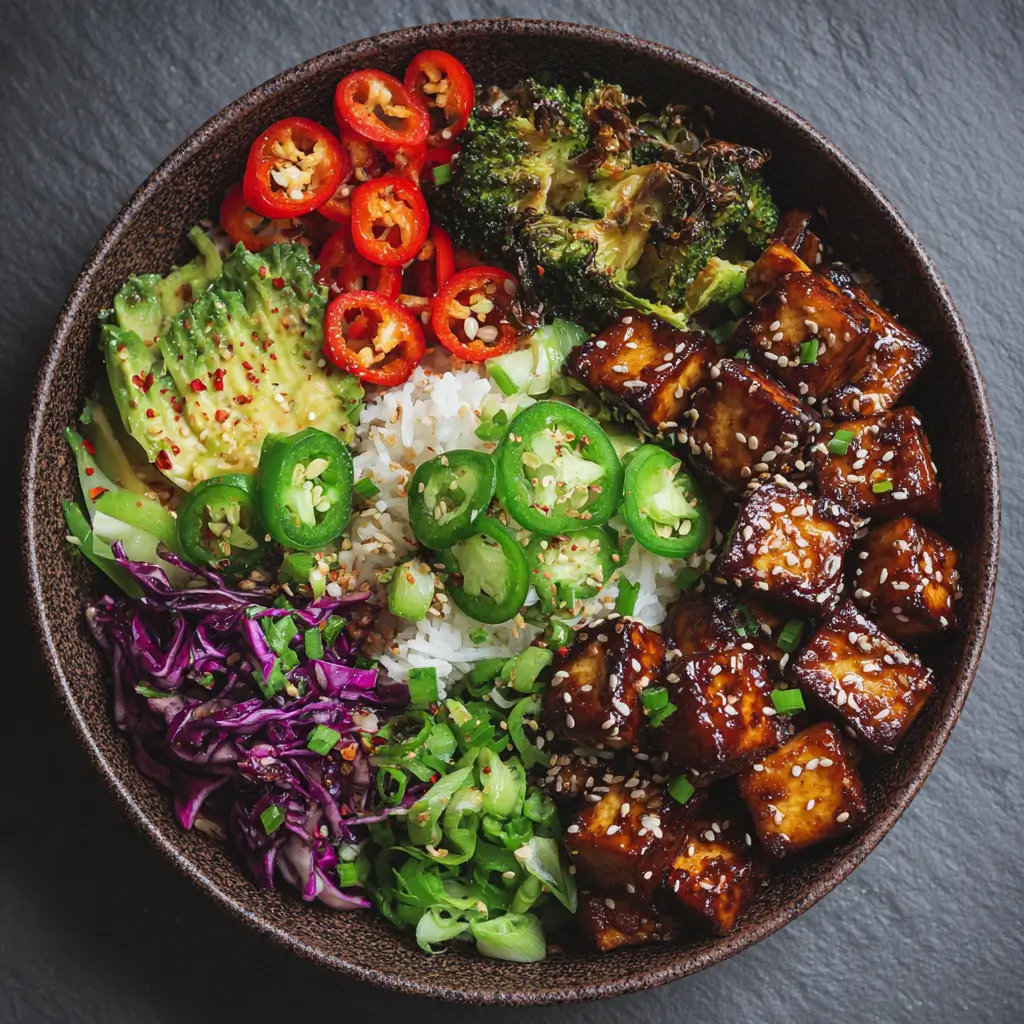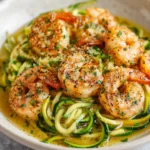Introduction
Teriyaki Glazed Tofu Bowls are a vibrant, wholesome, and satisfying meal that brings together the bold umami flavors of Japanese-inspired teriyaki sauce with the heartiness of plant-based protein and fresh vegetables. Perfect for lunch or dinner, this dish offers a balanced combination of savory, sweet, and slightly tangy notes that dance on your palate. Whether you’re a seasoned vegan, a vegetarian exploring new recipes, or simply someone looking to incorporate more plant-forward meals into your diet, these Teriyaki Glazed Tofu Bowls are sure to become a favorite. Packed with nutrition, easy to customize, and bursting with flavor, they offer both comfort and elegance in a single bowl.
The History
Teriyaki, as a cooking technique and flavor profile, originates from Japan, where it has been used for centuries to enhance the taste and appearance of fish and meat dishes. The word “teriyaki” comes from the Japanese terms teri, meaning luster or shine, and yaki, meaning grilled or broiled—referring to the glossy finish the glaze imparts when cooked. Traditionally, teriyaki sauce was made by simmering soy sauce, mirin (sweet rice wine), sake, and sugar, then brushing it onto proteins during grilling. Over time, this method spread beyond Japan and evolved, especially in American and fusion cuisines, where it began to be applied to chicken, salmon, beef, and eventually plant-based alternatives like tofu. Tofu itself has roots in Chinese cuisine, dating back over 2,000 years, but became widely embraced in Japan and throughout East Asia as a staple protein. The fusion of teriyaki sauce with pressed tofu is a modern culinary innovation, popularized in Western countries as part of the growing interest in healthy, flavorful, and sustainable food choices. Today, Teriyaki Glazed Tofu Bowls represent a harmonious blend of tradition and contemporary wellness trends, showcasing how global ingredients can come together in one delicious, nourishing plate.
Ingredients Breakdown
The magic of Teriyaki Glazed Tofu Bowls lies in the careful selection and balance of ingredients that contribute to both flavor and nutrition. Let’s take a deeper look at each component:
- Firm or Extra-Firm Tofu: This is the star protein of the dish. Choosing firm or extra-firm tofu ensures it holds its shape during pressing, marinating, and cooking. It’s rich in plant-based protein, calcium, and iron, and acts like a sponge, absorbing the teriyaki marinade beautifully.
- Soy Sauce or Tamari: Provides the salty backbone of the teriyaki sauce. Tamari is a gluten-free alternative with a richer, smoother flavor, ideal for those avoiding gluten.
- Mirin: A sweet rice wine that adds subtle sweetness and depth. If unavailable, a mix of rice vinegar and sugar can be substituted, though authentic mirin enhances authenticity.
- Low-Sodium Soy Sauce: Used in combination with regular soy sauce to control salt levels while maintaining flavor complexity.
- Brown Sugar or Honey (or Maple Syrup for Vegan Option): Adds the signature sweetness to the glaze. Brown sugar lends a molasses-like richness, while maple syrup keeps the recipe fully plant-based.
- Fresh Ginger and Garlic: These aromatics infuse the sauce with warmth, pungency, and a fragrant zing that elevates the entire dish.
- Rice Vinegar: Balances the sweetness with a touch of acidity, brightening the overall flavor profile.
- Cornstarch or Arrowroot Powder: Essential for thickening the sauce into a glossy, clingy glaze that coats the tofu perfectly.
- Toasted Sesame Oil: Drizzled sparingly for its intense nutty aroma and flavor, adding an authentic Asian flair.
- Vegetables: Common additions include bell peppers, broccoli, snap peas, carrots, and mushrooms—each contributing color, crunch, and nutrients. Feel free to use seasonal or frozen veggies for convenience.
- Cooked Rice or Grain Base: White or brown jasmine rice is classic, but quinoa, cauliflower rice, or sushi rice work wonderfully too. The grain soaks up the teriyaki sauce and grounds the bowl.
- Garnishes: Sliced green onions, sesame seeds, nori strips, pickled ginger, or chili flakes add texture, visual appeal, and bursts of flavor.
Step-by-Step Recipe
- Press the Tofu: Remove the tofu from its packaging and drain the liquid. Wrap it in a clean kitchen towel or paper towels and place a heavy object (like a skillet or books) on top. Press for 20–30 minutes to remove excess moisture. This step is crucial for achieving a firmer texture and better absorption of the marinade.
- Cut and Marinate: Once pressed, cut the tofu into 1-inch cubes or rectangular slabs. In a bowl, combine ¼ cup soy sauce, 2 tablespoons mirin, 1 tablespoon brown sugar, 1 minced garlic clove, and 1 teaspoon grated ginger. Add the tofu pieces and gently toss to coat. Let marinate for at least 20 minutes (or up to 2 hours in the fridge for deeper flavor).
- Prepare the Teriyaki Glaze: In a small saucepan, combine ½ cup soy sauce, ¼ cup mirin, 2 tablespoons brown sugar, 1 tablespoon rice vinegar, 1 teaspoon grated ginger, 1 minced garlic clove, and 1 tablespoon water. Bring to a gentle simmer over medium heat.
- Thicken the Sauce: In a separate small bowl, mix 1 tablespoon cornstarch with 2 tablespoons cold water to make a slurry. Slowly whisk the slurry into the simmering sauce. Continue stirring for 2–3 minutes until the sauce thickens into a glossy, pourable glaze. Remove from heat and set aside.
- Cook the Tofu: Heat 1 tablespoon of neutral oil (like avocado or vegetable oil) in a non-stick skillet over medium-high heat. Remove tofu from the marinade (reserve the marinade) and arrange in a single layer. Cook for 3–4 minutes per side, until golden brown and crispy. Pour the reserved marinade into the pan and cook for another 1–2 minutes, allowing the tofu to caramelize slightly.
- Glaze the Tofu: Reduce the heat to low and pour half of the prepared teriyaki glaze over the tofu. Gently toss to coat evenly. Cook for another 1–2 minutes so the glaze adheres and creates a sticky, shiny finish.
- Prepare the Vegetables: While the tofu cooks, steam, stir-fry, or roast your choice of vegetables. For a quick stir-fry, heat a little oil in a wok or large pan, add chopped veggies starting with the hardest (like carrots), then softer ones (like bell peppers and snap peas), and cook for 5–7 minutes until tender-crisp. Season lightly with salt and a splash of soy sauce.
- Cook the Rice: Prepare your preferred grain according to package instructions. For extra flavor, cook rice in vegetable broth instead of water.
- Assemble the Bowls: Divide the cooked rice among serving bowls. Top with glazed tofu, sautéed vegetables, and any additional toppings like sliced avocado, kimchi, or edamame.
- Garnish and Serve: Drizzle with remaining teriyaki sauce, sprinkle with sesame seeds and green onions, and serve immediately while warm.
Tips
- Extra Crispy Tofu: For a crispier texture, toss the pressed tofu cubes in 1–2 tablespoons of cornstarch before pan-frying. This creates a light, golden crust that holds up well to the glaze.
- Baking Option: Instead of pan-frying, bake the marinated tofu on a parchment-lined baking sheet at 400°F (200°C) for 25–30 minutes, flipping halfway through. Baking yields a chewier texture and requires less oil.
- Make Ahead: The teriyaki sauce can be made up to 5 days in advance and stored in an airtight container in the refrigerator. Reheat gently before using.
- Marinating Time: While 20 minutes is sufficient, marinating the tofu overnight dramatically enhances flavor penetration.
- Double the Glaze: The sauce reduces quickly, so consider doubling the glaze recipe if you love a saucier bowl or plan to serve leftovers.
- Use Fresh Aromatics: Freshly grated ginger and minced garlic make a noticeable difference compared to powdered versions.
- Balance Textures: Combine soft (tofu, rice), crunchy (vegetables, sesame seeds), and chewy (mushrooms, nori) elements for a more satisfying eating experience.
- Don’t Overcook Vegetables: Keep them vibrant and crisp-tender to preserve nutrients and contrast with the soft tofu and rice.
Variations and Customizations
One of the greatest strengths of Teriyaki Glazed Tofu Bowls is their adaptability. Here are some creative ways to switch things up:
- Protein Swaps: Replace tofu with tempeh, seitan, grilled chicken, salmon, or shrimp for different dietary preferences.
- Spicy Kick: Add sriracha, gochujang, or red pepper flakes to the teriyaki sauce for a fiery twist.
- Pineapple Addition: Incorporate fresh or grilled pineapple chunks into the bowl or even into the sauce for a tropical teriyaki variation.
- Grain Alternatives: Use quinoa, farro, millet, or mixed wild rice for added fiber and nuttiness. For a low-carb option, try riced broccoli or cabbage.
- Vegetable Rotations: Try bok choy, zucchini, asparagus, baby corn, water chestnuts, or cabbage depending on seasonality and availability.
- Nutty Crunch: Top with crushed peanuts, cashews, or almond slices for added protein and texture.
- Avocado Cream: Blend ripe avocado with lime juice, cilantro, and a splash of water for a creamy, dairy-free drizzle.
- Kimchi Boost: Add a spoonful of kimchi for probiotics, heat, and tangy complexity.
- Miso-Teriyaki Fusion: Stir 1 tablespoon of white miso paste into the teriyaki sauce for deeper umami and fermented richness.
- Meal Prep Friendly: Prepare components separately and store in airtight containers for up to 4 days. Assemble bowls fresh to prevent sogginess.
Health Considerations and Nutritional Value
Teriyaki Glazed Tofu Bowls can be a highly nutritious meal when prepared with mindful ingredient choices. Here’s a breakdown of the health benefits and considerations:
- Plant-Based Protein Power: Tofu is an excellent source of complete protein, containing all nine essential amino acids. A 3-ounce serving provides about 8–10 grams of protein, supporting muscle repair and satiety.
- Heart-Healthy Fats: Tofu contains unsaturated fats, including omega-3 fatty acids, which support cardiovascular health.
- Low in Cholesterol and Saturated Fat: Unlike animal proteins, tofu is naturally cholesterol-free and low in saturated fat, making it heart-friendly.
- Rich in Minerals: Tofu is a good source of calcium (especially if made with calcium sulfate), iron, magnesium, and phosphorus. Pairing it with vitamin C-rich vegetables (like bell peppers) enhances iron absorption.
- Fiber-Rich Vegetables: Adding a rainbow of veggies boosts fiber intake, aiding digestion, blood sugar control, and gut health.
- Watch Sodium Levels: Traditional soy sauce is high in sodium. Opt for low-sodium versions and control portion sizes. You can also dilute soy sauce with water or use coconut aminos as a lower-sodium alternative.
- Sugar Content: Store-bought or homemade teriyaki sauces can be high in sugar. Use natural sweeteners in moderation and consider reducing the amount by 25% without sacrificing flavor.
- Balanced Macronutrients: When served with whole grains and vegetables, this bowl offers a balanced ratio of carbohydrates, protein, and healthy fats—ideal for sustained energy.
- Gluten-Free Options: Use tamari instead of soy sauce and ensure all other ingredients are certified gluten-free for those with celiac disease or sensitivity.
- Allergen Awareness: Soy is a common allergen. For soy-free alternatives, consider using coconut aminos and substituting tofu with chickpeas or lentils (though the texture will differ).
A typical serving (without excessive sauce) contains approximately: 350–450 calories, 15–20g protein, 45–60g carbohydrates, 10–15g fat, and 5–8g fiber, depending on ingredients and portion sizes.
Ingredients
For the Tofu and Marinade:
- 1 block (14 oz) extra-firm tofu, pressed and cubed
- ¼ cup low-sodium soy sauce
- 2 tablespoons mirin
- 1 tablespoon brown sugar or maple syrup
- 1 clove garlic, minced
- 1 teaspoon fresh ginger, grated
For the Teriyaki Glaze:
- ½ cup low-sodium soy sauce
- ¼ cup mirin
- 2 tablespoons brown sugar or maple syrup
- 1 tablespoon rice vinegar
- 1 teaspoon fresh ginger, grated
- 1 clove garlic, minced
- 1 tablespoon cornstarch
- 2 tablespoons cold water
For the Bowls:
- 1 cup uncooked rice (white, brown, or jasmine)
- 1 tablespoon neutral oil (avocado, vegetable)
- 2 cups mixed vegetables (bell peppers, broccoli, carrots, snap peas)
- 1 tablespoon toasted sesame oil (for drizzling)
- 2 green onions, sliced
- 1 tablespoon sesame seeds
- Optional: avocado slices, kimchi, nori, edamame
Directions
- Press tofu for 20–30 minutes, then cut into cubes.
- In a bowl, whisk together marinade ingredients (¼ cup soy sauce, 2 tbsp mirin, 1 tbsp brown sugar, garlic, ginger). Add tofu and marinate for 20+ minutes.
- Cook rice according to package instructions.
- Heat oil in a skillet over medium-high heat. Remove tofu from marinade (reserve liquid) and cook 3–4 minutes per side until golden. Add reserved marinade and cook 1–2 minutes more.
- While tofu cooks, prepare vegetables via stir-fry, steam, or roast.
- Make teriyaki glaze: In a saucepan, combine soy sauce, mirin, brown sugar, rice vinegar, ginger, and garlic. Simmer 2 minutes.
- Whisk cornstarch with water, then stir into sauce. Cook 2–3 minutes until thickened. Remove from heat.
- Reduce heat to low, add half the glaze to the tofu, and toss to coat. Cook 1–2 minutes to glaze.
- Assemble bowls: rice, tofu, vegetables, garnishes.
- Drizzle with remaining glaze, sesame oil, and serve warm.
FAQ
- Can I use silken tofu?
- No, silken tofu is too soft and will fall apart. Always use firm or extra-firm tofu for this recipe.
- How do I store leftovers?
- Store components separately in airtight containers in the refrigerator for up to 4 days. Reheat tofu and veggies in a skillet or microwave.
- Can I freeze teriyaki tofu?
- Yes, cooked teriyaki tofu freezes well for up to 3 months. Thaw in the fridge and reheat on the stove for best texture.
- Is teriyaki sauce vegan?
- Most are, but check labels—some contain honey. Use maple syrup or agave to keep it plant-based.
- What can I use instead of mirin?
- Substitute with 1 tablespoon rice vinegar + 1 tablespoon sugar, or dry sherry in a pinch.
- Why is my sauce too thin?
- You may need more cornstarch. Mix another ½ tablespoon with 1 tablespoon water and whisk into simmering sauce.
- Can I make this gluten-free?
- Easily! Use tamari instead of soy sauce and ensure all other ingredients are gluten-free.
- How do I prevent soggy tofu?
- Press thoroughly, use high heat when cooking, and avoid covering the pan. Don’t overcrowd the skillet.
- Can I use store-bought teriyaki sauce?
- Yes, but homemade allows control over sugar, sodium, and freshness. If using store-bought, choose low-sodium and organic options.
- Are these bowls kid-friendly?
- Absolutely! Kids love the sweet-savory flavor. Serve with fun veggies and let them build their own bowls.
Summary
Teriyaki Glazed Tofu Bowls are a delicious, nutritious, and versatile meal that combines savory-sweet teriyaki sauce with crispy tofu, fresh vegetables, and fluffy rice for a satisfying plant-based experience. Easy to customize and perfect for meal prep, this bowl brings restaurant-quality flavor to your home kitchen with minimal effort.










